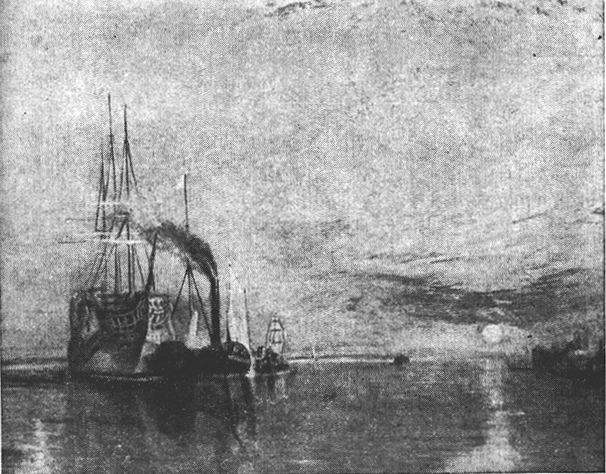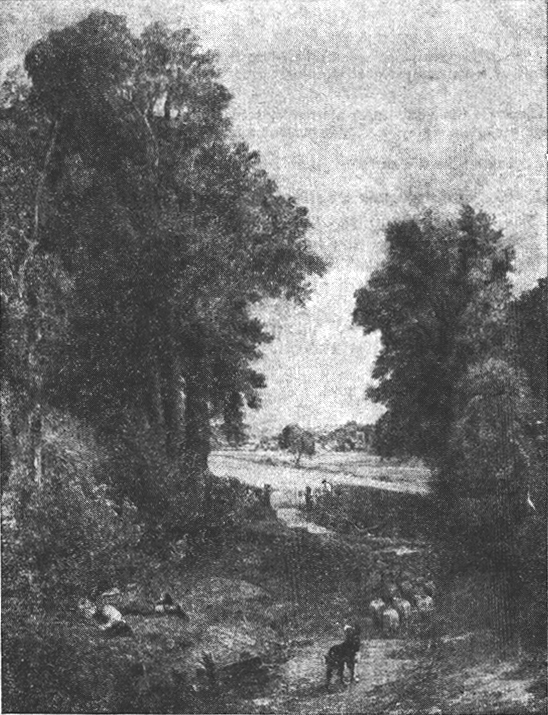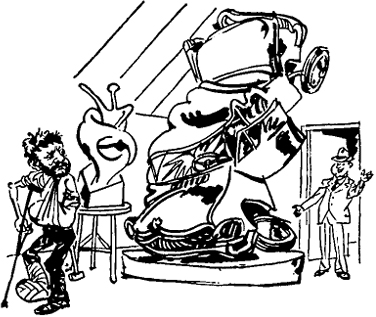I. Study the text and retell it.
Dora had been in the National Gallery a thousand times and the pictures were almost as familiar to her as her own face. Passing between them now, as through a well-loved grove, she felt a calm descending on
146
her. She wandered a little, watching with compassion the poor visitors armed with guide books who were peering anxiously at the masterpieces. Dora did not need to peer. She could look, as one can at last when one knows a great thing very well, confronting it with a dignity which it has itself conferred. She felt that the pictures belonged to her, and reflected ruefully that they were about the only thing that did. Vaguely, consoled by the presence of something welcoming and responding in the place, her footsteps took her to various shrines at which she had worshipped so often before: the great light spaces of Italian pictures, more vast and southern than any real South, the angels of Botticelli, radiant as birds, delighted as gods, and curling like tendrils of a vine, the glorious carnal presence of Susanna Fourment,1 the tragic presence of Margarethe Trip,2 the solemn world of Piero della Francesca with its early-morning colours, the enclosed and gilded world of Crivelli. Dora stopped at last in front of Gainsborough's picture of his two daughters. These children step through a wood hand in hand, their garments shimmering, their eyes serious and dark, their two pale heads, round full buds, like yet unlike.
Dora was always moved by the pictures. Today she was moved, but in a new way. She marvelled, with a kind of gratitude, that they were all still here, and her heart was filled with love for the pictures, their authority, their marvellous generosity, their splendour ...
The pictures were something real outside herself, which spoke to her kindly and yet in sovereign tones, something superior and good whose presence destroyed the dreary trance-like solipsism of her earlier mood. When the world had seemed to be subjective it had seemed to be without interest or value. But now there was something else in it after all.
These thoughts, not clearly articulated flitted through Dora's mind. She had never thought about the pictures in this way before; nor did she draw now any very explicit moral. Yet she felt that she had had a revelation. She looked at the radiant, sombre, tender, powerful canvas of Gainsborough and felt a sudden desire to go down on her knees before it, embracing it, shedding tears.
(From "The Bell" by Iris Murdoch)
II. Answer the following questions:
- What do you know about the National Gallery in London? Where is it situated? What schools of painting are represented there? Can you name any famous pictures?
- What other world famous picture galleries do you know? Is there a picture gallery in your native town? What is it like?
- What did Dora think about the Italian pictures? How are Botticelli's angels described? What is the subject of Botticelli's famous pictures "The Birth of Venus" and "Primavera" ("The Spring")? What type
147
of feminine beauty did Botticelli create? What other great Italian painters do you know?
4. How do you understand the phrase "glorious carnal presence of Susanna Fourment"? What type of feminine beauty did Rubens glorify? What colour scheme predominates in his battle and hunting scenes, mythological subjects and grand-style portraiture? What pictures belonging to the brush of this outstanding Flemish painter are to be found in the Hermitage in Leningrad?
5. Why do the portraits of old men and women painted by Rembrandt in the last decade of his life possess a deeply tragic outlook? By what means did he achieve dramatic tension? In what branches of painting was Rembrandt a master? Do you know that the Rembrandt collection of the Leningrad Hermitage is one of the richest in the world? Can you describe one of these paintings? ("The Return of the Prodigal Son", "Danae", "Flora", "Portrait of an Old Man in Red", "Woman Trying on her Ear-Rings", "Old Warrior")
6. What are guide books for? Do you need a guide book in a picture gallery? Do you enjoy visiting exhibitions and galleries? What picture:-; appeal to you most? Have you ever been moved by a painting in a special way?
III. Comment on the following:
1. ... the pictures were as familiar to her as her own face. 2. ... watching with compassion the poor visitors armed with guide books. 3. She felt that the pictures belonged to her. 4. ... various shrines at which she had worshipped so often. 5. She marvelled, with a kind of gratitude, that they were still here. 6. The pictures ... spoke to her kindly yet in sovereign tones. 7. She felt that she had had a revelation.
IV. Give a written account of your own visit to a picture gallery.
V. Read Chapter I of "To Let" by J. Galsworthy and describe Soames Forsyte's impression of the exhibits he saw in the Art Gallery.
VI. Read the texts and get ready to discuss them in the classroom:
Thomas Gainsborough (1727-1788), English portrait and landscape painter, one of the greatest of all English artists, was born at Sudbury, England. First in Ipswich, then in Bath, and finally in London, he worked as a fashionable portrait painter, gradually acquiring a large lucrative practice and rivalling Sir Joshua Reynolds himself. What distinguished him from Reynolds was his greater independence of the old masters. For while Reynolds had studied the classical art of Italy, Gainsborough in his rural seclusion had developed mainly by the study of nature. He was among the first English artists who represented the scenery of their own native land thus breaking with the tradition, followed by his predecessors and contemporaries of painting imaginary Italian Scenery in the style of Claude le Lorrain.
148
Gainsborough is famous for the elegance of his portraits and his pictures of women in particular have an extreme delicacy and refinement, As a colourist he has had few rivals among English painters. His best works have those delicate brush strokes which are found in Rubens and
 T, Gainsborough.
T, Gainsborough. Mrs. Sarah Siddons,
Renoir. They are painted in clear and transparent tone, in a colour scheme where blue and green predominate. He often placed his figures against a landscape background which harmonized with the sentiment animating the sitter. In the portrait of "Robert Andrews and Mary, His Wife", for example, the beauty of the green English summer is communicated to the viewer through the sense of well-being and delight which the atmosphere
149
visibly creates in the sitters. Gainsborough shows the pleasure of resting on a rustic bench in the cool shade of an oak tree, while all around the ripe harvest throbs in a hot atmosphere enveloped by a golden light. Gainsborough is well represented in the national galleries of London, Ireland, Scotland and in many private collections.
The "Mrs Siddons" by Gainsborough has the distinction of being not only a remarkable work of art, but a unique interpretation of a unique personality. It is not only one of the artist's finest portraits, but also one of the best of the many likenesses of the great tragic actress, who sat to most of the celebrated masters of her day. It was painted in 1784, when the queen of the tragic drama was in her twenty-ninth year and at the zenith of her fame. It was as Lady Macbeth that Mrs Siddons achieved her greatest triumphs and her realization of the despair of the murderess has never been surpassed. Not even the "Mrs Siddons as the Tragic Muse" of Sir Joshua Reynolds, painted the year before Gainsborough's portrait, does such full justice to the "living Melpomena", as she was called in her lifetime. Gainsborough never yielded, as his great rival did sometimes, to the temptation to merge the character of his sitter in that of some outworn classic model. He was too true a realist ever to borrow motives, and his Mrs Siddons, fine interpretation as it is of a noble nature, will never cease to appeal to all who are able to appreciate what she was as a woman as well as an actress.
"The Fighting Téméraire" is certainly the most famous of Turner's landscapes, and it is one of the most profound and moving pictures ever painted. It contains all the definite drawing of his earlier works without any loss of colour; and all the glory of the later colour without any vagueness. It has all his splendour of invention, with all his depth of feeling. It is significant that he refused to sell it and that it is said to have been his favourite among his works. He had seen the Old Téméraire, the second ship of the line at the battle of Trafalgar, towed to her last berth-sold to the wreckers; and he transmuted the scene into an emblem of destruction.
"A mighty red sun, amidst a host of flaring clouds," wrote W. Thackeray, "sinks to rest on one side of the picture and illumines a river that seems interminable, and a countless navy that fades away into such a wonderful distance as never was painted before. The little demon of a steamer is belching out a volume of foul, lurid, red-hot malignant smoke, paddling furiously and lashing up the water round about it, while beyond it slow, sad, majestic follows the brave old ship, with death, as it were, written on her.
150
It is absurd, you will say, to grow enthusiastic about a four-foot canvas representing a ship, a steamer, a river and a sunset. But herein lies the power of the artist. He makes you see and think a great deal more than the objects before you."
 W. Turner.
W. Turner. "The Fighting Temeraire".
VII. Render the following into English:
Гейнсборо был создателем и основоположником "портрета настроения", ему особенно удаются женские, юношеские, детские образы "Портрет герцогини де Бофор", "Портрет племянника Гейнсборо Дю-понта", "Голубой мальчик", "Собиратели хвороста". Художник смотрит на модели словно бы сквозь тонкую и почти осязаемую дымку рассеивающегося тумана, так часто окутывающего страну-остров. И эта серебристо-голубая с перламутровыми бликами и синеватыми тенями гамма придает портретам Гейнсборо мечтательную поэзию, возвышенное изящество.
Умение Гейнсборо безошибочно схватить сходство и придать поэтичность образу, изящество его свободной техники сделали его любимым
151
портретистом светских дам. "Если б люди с их проклятыми портретами оставили меня хоть немножко в покос, мне кажется, я показал бы себя в лучшем свете",- жалуется художник, мечтавший безраздельно посвятить себя писанию пейзажей. Но судьба распорядилась вопреки его желаниям. Пришлось почти всю жизнь провести в Лондоне, зарабатывать на существование портретами (английские пейзажи в Англии не покупались) и все творческие силы отдать им, хотя сегодня его пейзажи причисляются к лучшему из созданного в этом виде живописи.
Сара Сиддонс, прославленная исполнительница шекспировских ролей, неоднократно изображалась художниками. Рейнольде написал ее в виде музы трагедии, величественно восседающей на троне среди облаков в окружении аллегорических фигур. Гейнсборо был чужд подобный выспренный стиль, и он изобразил актрису в обычном городском платье и большой шляпе с перьями, словно она невзначай зашла к нему в мастерскую и присела на стул, положив муфту на колени. Однако даже саMorо беглого взгляда на картину достаточно, чтобы увидеть, что это не просто салонный портрет и не просто светская дама. Тонкое нервное лицо, смелый умный взгляд говорят о незаурядной личности, о человеке большой интеллектуальной глубины, страстного темперамента и сильного волевого характера. Гейнсборо и не подумал смягчить черты резко прорисованного профиля своей знаменитой модели. "Черт побери ваш нос, мадам, ему просто конца нет!" - ворчал он во время работы, и тем не менее созданный им образ покоряет своей гордой и одухотворенной красотой.
Однажды художник увидел на Темзе, как буксирный пароход тащил на слом старый военный корабль. Это был "Отважный", участник Трафальгарского сражения. Под этим впечатлением Тернер написал картину "Последний рейс корабля "Отважный"". В свете феерически яркого заката старый корабль совершает свой последний путь, ведомый его неуклюжим вожатым. Пароход движется уверенно и грузно, дым и пламя, вылетающие из его трубы, спорят со светом заката, пена расходится из-под его раздутых боков. Словно какая-то новая стихия вторгается в мир. Если в лучших ранних работах Тернеру удавалось, изображая самое, казалось бы, расплывчатое, сохранить во всем упругость, крепость, то в зрелую пору - с 20-х гг. до начала 40-х гг.- он умел всюду, во всем найти россыпь драгоценных красок.
VIII. Write a short composition about a painting for which you have a genuine affection modelling it to a certain extent on the text below:
For Constable I have an affection that goes back to my earliest recollections. In the first years of my childhood, there hung in the halls
152
of my father's house a large steel-engraving of "The Cornfield". Often in the long hot summers of the Middle West, I used to lie on the floor, gazing for hours into this English landscape carried from the dry and burning world around me into a vista of blessed coolness, thick verdure,
 J. Constable,
J. Constable, The Cornfield, or Country Lane.
dampness and everlasting peace. I lived in that picture. To me it was more beautiful than a dream: the boy, flat on the ground drinking from a running brook; the sheep dog waiting patiently with turned head; the ambling flock; the old silent trees; the fat clouds reeking moisture ...
153
Some years later, when I went to London to study pictures, I saw "The Cornfield" and many others by Constable, and my first impressions were confirmed. In his grasp of the stable, one might almost say formidable, repose that man feels in the presence of nature, and in communicating the spiritual contentment induced by companionship with nature, Constable is the master of the English school.
(From "Men of Art" by Thomas Craven)
IX. Describe three paintings: a) half-length intimate portrait; b) self-portrait; c) portrait of a famous personality.
X. Describe three paintings: a) country scene; b) seascape; c) painting where a landscape background plays a very important role.
XI. Speak on the life and work of an outstanding Russian painter.
XII. Make up dialogues on the situations suggested below:
- Two friends doing the Tretyakov Gallery.
- A foreigner sharing his impressions of the Hermitage.
- Father and son in the Tretyakov Gallery in the room where Vasnetzov's pictures are on display.
- Two art lovers discussing a famous canvas and its history ("Mona Liza" by Leonardo da Vinci, "The Trinity" by A. Rublev, "Sistine Madonna" by Raphael, "An Unknown Woman" by Kramskoi).
XIII. Comment on the pictures.

It is undoubtedly your best!
|
 VISITOR: What a lovely picture you've painted! I only wish I could take some of these gorgeous colours home with me.ARTIST: Don't worry, my friend, you will. You've been sitting on my paint box all this time!
VISITOR: What a lovely picture you've painted! I only wish I could take some of these gorgeous colours home with me.ARTIST: Don't worry, my friend, you will. You've been sitting on my paint box all this time!
|
154
XIV. Help the artist to find the right colours by putting two word-pieces together.
XV. Give a critical review of a book about a painter ("Lust for Life" by I. Stone, "It's Me 0 Lord" by R. Kent, "The Light that Failed" by R. Kipling, "A Thing of Beauty" by A.J. Cronin, "The Horse's Mouth" by J. Carry, "The Moon and Sixpence" by S. Maugham or any other).
XVI. Give a brief talk on one of the following topics:
- An outstanding English painter (Hogarth, Reynolds, Gainsborough, Stubbs, Romney, Morland, Lawrence, Constable, Turner, Whistl-er).
- Impressionism and its role in the history of art.
- The Wanderers.
- The Hermitage, Leningrad.
- The Tretyakov Art Gallery, Moscow.
- The Pushkin Fine Arts Museum, Moscow.
- The National Gallery, London.
- The Metropolitan Museum, New York.
Try Your Hand at Teaching
I. Make a list of words and phrases from school vocabulary to be used in the description of a painting. Ask your fellow students to discuss pictures using them.
II. Pick out the most important facts about the life and work of Th. Gainsborough and adapt the material for secondary school pupils.
III. Collect jokes, short stories and pictures suitable for schoolchildren to discuss.
155
1
One of the most beautiful of Rubens's portraits of women is supposed to represent Susanna Fourment, his second wife's sister. Here Rubens employs his amazing skill to give a delicately pearly effect of flesh as if seen in the open air.
2
"Margarethe Trip" is a portrait of an old woman by Rembrandt van Rijn where the painter succeeded in suggesting the isolation and loneliness of old age with its premonition of death.
